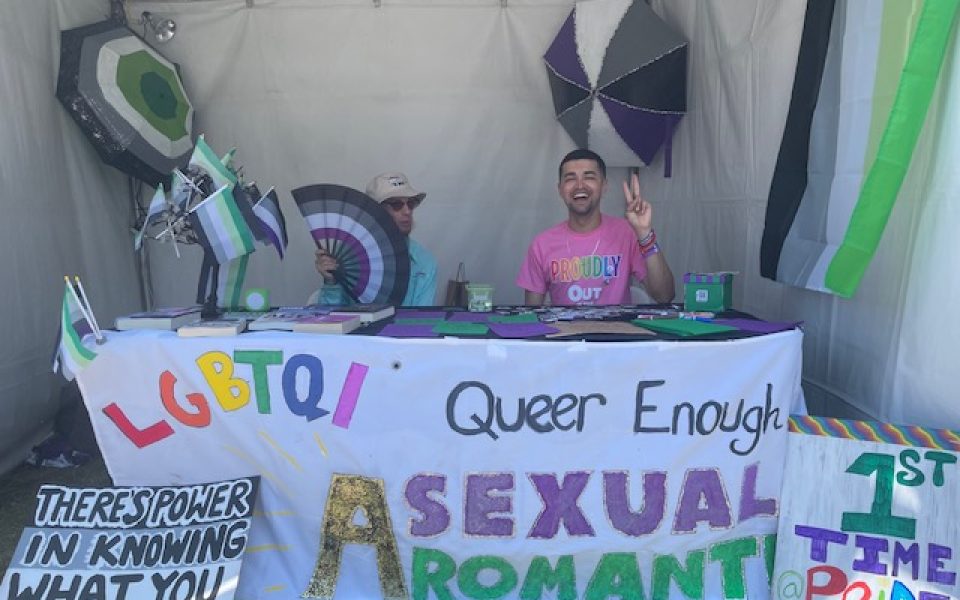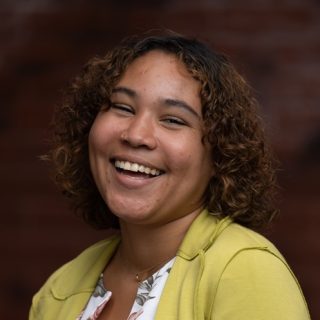Featured photo: A picture of Shane Cricket and some friends at an Asexual and Aromantic booth at a Pride Festival. The poster at the bottom that says “There is power in knowing what you don’t want.” (courtesy photo)
Being the last letter of an acronym comes with its disadvantages.
Despite making up about 1.7 percent of all adults in the US, asexual and aromantic people continue to face misconceptions about their identity.
“We just don’t find other people sexually attractive or meet someone and desire them sexually,” says Mel Loyd, an aro-ace, or an aromantic-asexual living in Greensboro.
According to the Trevor Project, asexuality — represented by the “A” in the LGBTQIA+ spectrum — is an umbrella term for the lack of physical and/or sexual attraction. Asexual people are also known as “Ace” or “Aces.” Slightly different from asexual, are people who identify as aromantic. Aromantic means not experiencing any romantic attraction to any gender. An example of this could be never experiencing the feeling of having a crush and not understanding that feeling either. Aromantic people are also known as “Aro” or “Aros.” Both exist on a spectrum and can be referred to as “gray,” according to the Trevor Project.
“Not all asexual people are aromantic, and not all aromantic people are asexual,” Shane Cricket, an asexual and aromantic facilitator of a statewide online support group on Meetup called Asexuals and Aromantics of North Carolina explains.

The asexual and aromantic community acknowledge a split-attraction model, meaning people can experience both romantic and sexual attraction to others in different, and separate, ways, according to Cricket. For example, a person could be heteroromantic and bisexual or homosexual and aromantic to name a few variations of the wide spectrum of asexuality.
While it may sound like celibacy, it’s not, says Meadow Allen, a local aromatic-asexual.
“Celibacy is a choice; asexuality is not,” Allen says. “Celibates feel attraction, feel desire and simply choose not to act on these impulses. Asexuals have no such choice as to how we feel.”
Since asexuality is on a spectrum, some people in the ace community do feel sexual attraction, such as L. Williams, who only realized she was ace last year.
“I do feel sexual attraction from time to time, but it’s not really something that takes up a major part of my life,” Williams says. “Occasionally having sex or being attracted to someone does not make me any less asexual; it just shows the complexity that is the human condition.”
Like many of the other sexualities and identities on the LGBTQ+ spectrum, asexual and aromantic people continue to battle widespread misconceptions.
“In a society that is so sex- and romance-focused, our platonic feelings are made to seem less important and meaningful than sexual/romantic feelings and desires,” says Mel Loyd, a member of Asexuals and Aromantics of North Carolina.
For many asexual people, questioning if something is wrong with them is also common.
“I questioned if I was broken, had a hormone imbalance, or had some sort of trauma,” Cricket says. “I forced myself to have sex with people hoping someday I would be into it, and thinking that no relationship would ever be healthy without a healthy sex life.”
Then, six years ago, Cricket joined a local asexual community and found hundreds like himself.
“I discovered the word asexual and was immediately relieved,” he says. “I remember crying from finally finding an answer, and that nothing was actually wrong with me.”
When Cricket moved to North Carolina from California during the pandemic, he discovered a need for resources specifically for the ace community across the state.
“I always knew I was different,” he says. “But, I never quite fit in with other LGBT people, and it was always so isolating.”
So, Cricket took it upon himself to create an online support group on Meetup called Asexuals and Aromantics of North Carolina, which he describes as “life-changing.”
“I knew there were asexual and aromantic people everywhere, and that we just needed a way to find each other,” Cricket says. “After meeting so many people through these groups, I can easily say that I have found my people.”
The online Meetup group takes place on the second Monday of every month. Recently, the group has begun to meet in-person occasionally too.
Cricket also found an asexual dating group, which can be a cause for anxiety for some people in the ace community. And that’s because the rules are fluid; some in the ace community date non-ace individuals and some don’t — it’s personal.
“A sex-favorable ace may have an easier time dating, since an aversion to sex is often a deal-breaker for most allosexuals (non-ace people),” Loyd explains.
Establishing trust is a huge priority to the delicate balance of sex in a relationship with an asexual and allosexual person.
“To avoid relationships where we’ll feel pressured to compromise our personal Boundaries we need to be up front and open about our personal asexual experience with any potential partner,” Loyd says.

However, the difficulty of finding an accepting partner for some asexual people means that many aces are much more comfortable, or only comfortable, dating within the community.
“While not impossible, it’s difficult,” Allen says. “Personally, I’m a sex repulsed aro-ace. I won’t participate in sexual activity whatsoever. In order to date an allosexual person, I would have to find someone who would be accommodating to the lack of a physical intimate relationship.”
Ultimately, the ace community is made up of a diverse spectrum of identities. Ace, gray, asexual and aromantic all are unique.
“To me, asexuality is a comfort that I am not alone,” Allen says. “It is the understanding that I am not broken, and that I am allowed to not be comfortable with certain things deemed ‘normal’ by the majority of people.”
Additional advice for those curious about asexuality:
- Meadow Allen: “The most important thing is to listen to yourself. You never have to label yourself asexual if that isn’t your thing, but don’t let yourself be pushed into situations you aren’t comfortable with just for the sake of ‘feeling normal.’ “
- Mel Loyd: “Trust that you know yourself, and your experiences and feelings. You don’t have to be pressured into any situation because it’s what everyone is supposed to want. Take your time to understand your own comfort and boundaries, and do what will make you personally feel happiest.”
- Shane Cricket: “For anyone who thinks they might be asexual and/or aromantic, they are welcome to attend a virtual support group on Meetup called Asexuals and Aromantics of North Carolina. It is a discussion group for all asexual-spectrum, aromantic-spectrum and questioning people who are 18 years and older. All meetings are free, and led by a peer-facilitator.”
For those wanting to be better allies:
- Meadow Allen: “Just listen. Just accept that they know themselves better than you would. Just listen, and accept. The more people become aware that we even exist, the easier things will be for every asexual. Having to explain what asexuality means every time you dare to bring it up to a new person can be exhausting, and it’s extremely rare that someone understands.”
- Mel Loyd: “Accept us and how we identify ourselves. Trust that we know ourselves and our experiences, and that we don’t need to ‘find the right person’ or overcome what many perceive as a flaw, but are just having a different experience than most people.”
For more information and support about the Ace community, visit asexuality.org.
To meet other people in the Ace community around the Triad, visit asexualitic.com/groups/north-carolina-aces/ or meetup.com/asexuals-and-aromantics-of-north-carolina/?action=join.
Join the First Amendment Society, a membership that goes directly to funding TCB‘s newsroom.
We believe that reporting can save the world.
The TCB First Amendment Society recognizes the vital role of a free, unfettered press with a bundling of local experiences designed to build community, and unique engagements with our newsroom that will help you understand, and shape, local journalism’s critical role in uplifting the people in our cities.
All revenue goes directly into the newsroom as reporters’ salaries and freelance commissions.


Leave a Reply